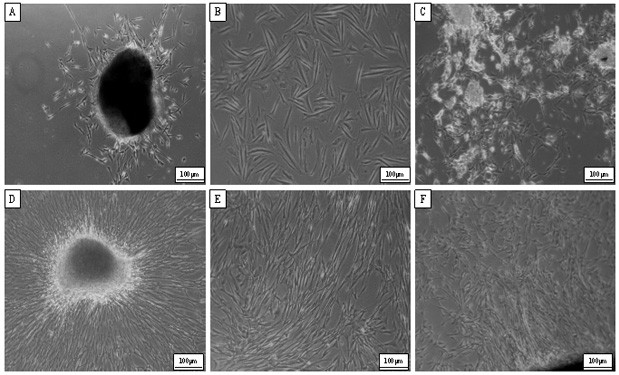Takifugu bimaculatus testis tissue cell line and application thereof
A technology of tissue cells and cell lines, applied in the biological field, can solve problems such as failure to achieve expected effects, and achieve the effects of preventing cell contamination, good adherence rate, and easy digestion.
- Summary
- Abstract
- Description
- Claims
- Application Information
AI Technical Summary
Problems solved by technology
Method used
Image
Examples
Embodiment 1
[0042] A method for establishing a testicular tissue cell line (TBTc) of double-spotted pufferfish, comprising the following steps:
[0043] (1) Obtainment of testis tissue of the double-spotted pufferfish: 7 months old and 8-10 cm long juveniles of the double-spotted pufferfish were temporarily cultured in sterilized seawater containing three antibodies for 1 to 2 hours, using the addition of 1wt‰ The sterilized seawater of sodium hypochlorite was used to disinfect the fish surface for 15 minutes. At the end, drop 0.005 - 0.015% of eugenol in the volume of sterilized seawater until the fish is turned over, the abdomen is up, and there is no stress response to the stimulation, wipe the mucus on the surface of the fish with a sterilized gauze piece, and then soak it with alcohol After wiping the surface of the fish body with gauze, the fish body was moved into the ultra-clean bench, and the gonad tissue was taken out with a dissecting instrument, and a small part was placed in ...
Embodiment 2
[0073] Example 1 Cryopreservation and recovery of the testis cell line of the double-spotted pufferfish.
[0074] (1) Frozen storage: take a bottle of 75cm 2 The cells of the testicular cell line of the double-spotted pufferfish that grew vigorously and covered the bottom of the culture flask were digested with 0.25wt% trypsin. After centrifugation, the cell pellet was collected, and 3 mL of the prepared cell freezing solution was slowly added, and gently pipetted The cells are dispersed evenly in the cell cryopreservation solution, and the liquid is transferred into the cryovial using a pipette. Using a cell characterization analyzer, analyze and count the cell suspension ( Figure 4 A), adjust the cell concentration so that the number of cells per mL of cryopreservation solution is 1 × 10 6 , use a pipette to transfer the liquid into the cryovial. The cryovials were placed at 4 °C for 1 h, then placed in a programmed gradient cooling freezing box (the temperature drop ra...
Embodiment 3
[0079] The influence of the proliferation curve of different passage ratios of the testicular cell line of the double-spotted pufferfish in Example 1:
[0080] Cells with good shape and vigorous proliferation were selected from the testicular cell line established in Example 1, digested and passaged, and passaged to 25 cm at 1:2, 1:3, 1:5 and 1:10 respectively. 2 Cell culture flasks (that is, inoculate 5 × 10 5 , 3.3×10 5 , 2×10 5 , 1 × 10 5 6 cells in each group in parallel, and then make up the total volume of the solution in each flask to 5 mL with complete culture medium). From 24 h of passage, one flask of cells in each group was digested every 24 h, and the cells in each group were counted by a cell characteristic analyzer and analyzed by graph.
[0081] like Figure 5 As shown in A, for the testis cell line of the double-spotted pufferfish, different passage ratios have a great influence on the cells. Except for the 1:2 and 1:3 passage groups, the proliferation of...
PUM
 Login to View More
Login to View More Abstract
Description
Claims
Application Information
 Login to View More
Login to View More - R&D
- Intellectual Property
- Life Sciences
- Materials
- Tech Scout
- Unparalleled Data Quality
- Higher Quality Content
- 60% Fewer Hallucinations
Browse by: Latest US Patents, China's latest patents, Technical Efficacy Thesaurus, Application Domain, Technology Topic, Popular Technical Reports.
© 2025 PatSnap. All rights reserved.Legal|Privacy policy|Modern Slavery Act Transparency Statement|Sitemap|About US| Contact US: help@patsnap.com



